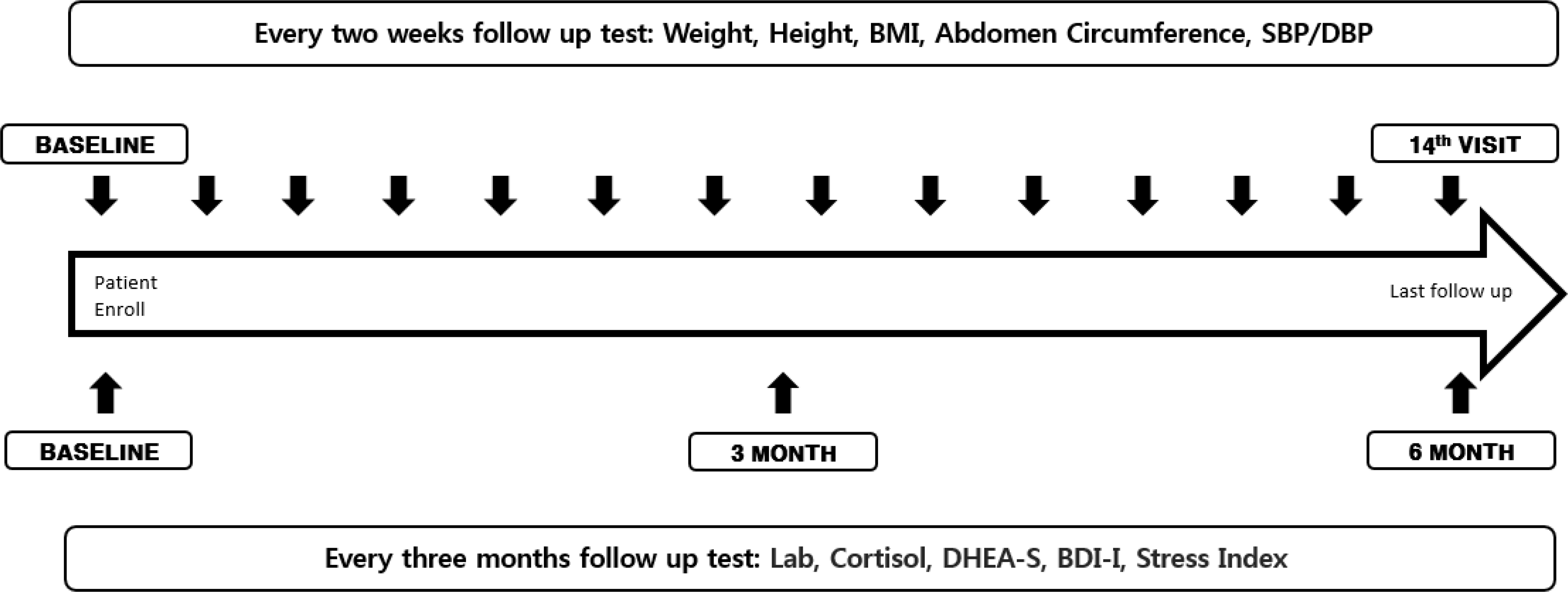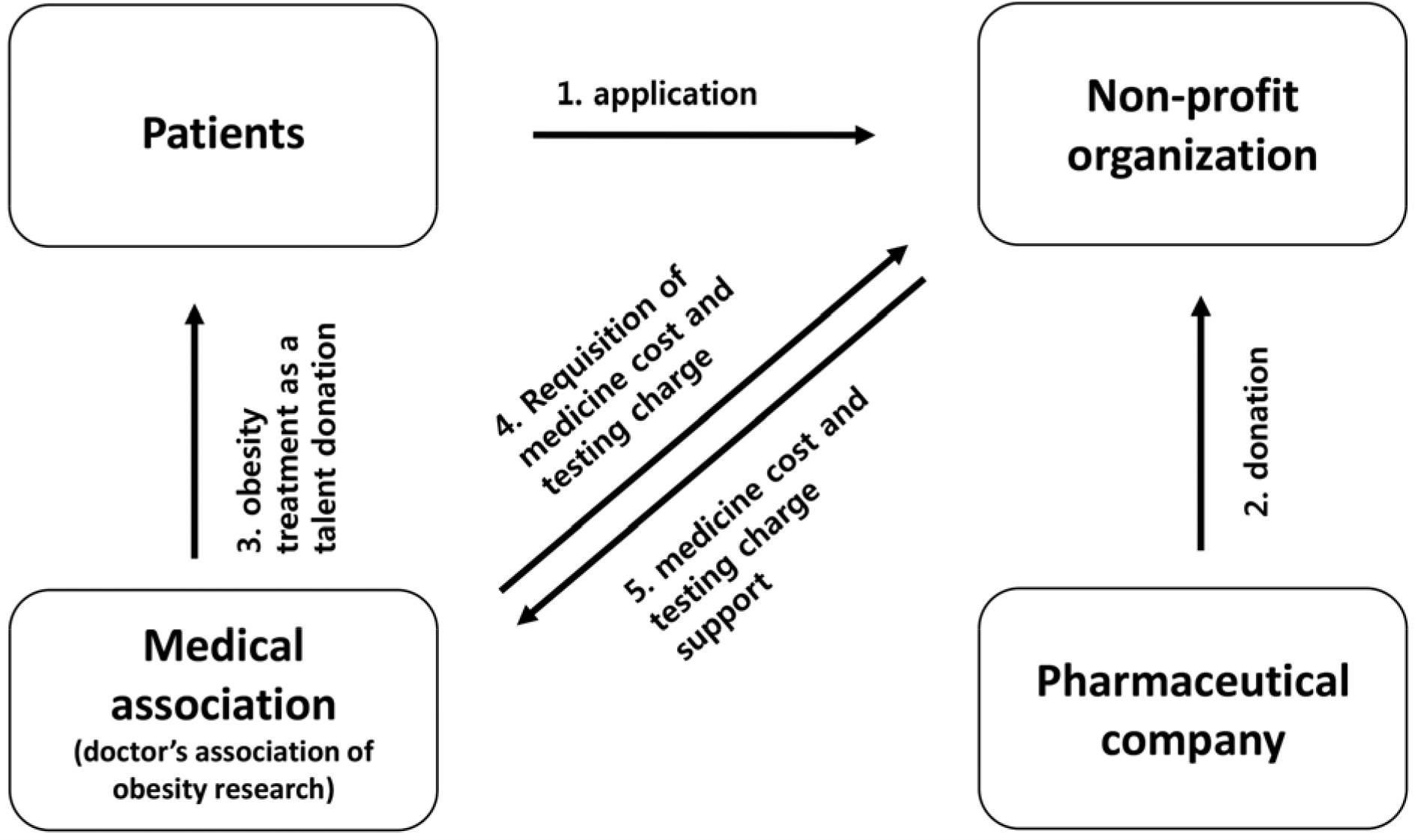Prospective Study for Evaluating Therapeutic Efficacy of Obese Patients of Low Socioeconomic Status in Korea
- Sang Joon An1, Eun-Jung Park2, Ji-Hyeon Cheon3, Hee-Jin Hwang4, Min-Jeong Kim5
- Received June 01, 2017 Accepted June 25, 2017
- ABSTRACT
-
- Background:
- Recently, the prevalence of obesity and socioeconomic costs stemming from obesity are increasing steeply. Obesity, in particular, has a highly polarization caused by income levels. Obesity in low-income patients is expected to become a serious social problem in the future. This study aims to observe the effects of consistent consultation and drug therapy during a six months period, and to develop the treatment process of obesity for low-income people.
- Methods:
- The body weight, waist circumference, body mass index (BMI), and blood pressure (BP) was measured every 2 weeks, and laboratory blood tests with a survey including Beck Depression Inventory (BDI) and eating behavior index was checked at 0, 3, and 6 months. Paired t-test and linear mixed model was done to evaluate the difference between pre-treatment data and post-treatment data.
- Results:
- Twenty-one patients (2 males, median age [interquartile range] of 39 years [29-46]) were analyzed. There were statistically significant reductions of body weight (P<0.01), BMI (P<0.01), waist circumference (P<0.01), low-density lipoprotein (P=0.01), BDI-I (P<0.01), eating behavior index (P<0.01). There was no statistically significant difference of safety outcome of the BP and blood tests.
- Conclusions:
- Proper obesity treatment of obese patients of low socioeconomic status was meaningful enough to affect depression and eating patterns as well as reducing body weight and decreased waist circumference.
Table 1.
Baseline characteristics of 21 patients
Table 2.
Every 2 weeks follow up data of the 21 patients for 26 weeks
Table 3.
Difference between baseline and 3 months and 6 months
| Parameter Body weight | Baseline 96.2±19.9 | 3 months 86.2±18.1 | N 24 | P <0.001a | Difference 10.0±5.0 | Baseline 100.4±23.0 | 6 months 84.7±22.0 | N 21 | P <0.000 | Difference 15.7±7.6 |
|---|---|---|---|---|---|---|---|---|---|---|
| BMI | 36.3±6.1 | 32.6±5.6 | 24 | <0.001a | 3.7±1.7 | 37.7±6.9 | 31.9±6.7 | 21 | <0.000 | 5.8±2.9 |
| WC | 114.4±13.1 | 106.3±16.0 | 24 | <0.001a | 8.1±5.4 | 114.8±15.3 | 102.6±20.5 | 21 | 0.001a | 12.2±9.1 |
| Total cholesterol | 192.6±34.5 | 178.3±21.8 | 24 | 0.030a | 14.3±27.3 | 192.7±38.9 | 173.8±22.4 | 21 | 0.141a | 18.9±41.4 |
| HDL-cholesterol | 52.3±11.9 | 48.9±11.7 | 24 | 0.053a | 3.4±7.4 | 52.5±13.2 | 52.3±8.8 | 21 | 0.904b | 0.3±7.0 |
| LDL-cholesterol | 126.6±33.0 | 115.4±20.4 | 24 | 0.049a | 11.2±23.7 | 125.1±39.0 | 106.2±23.6 | 21 | 0.092a | 18.9±35.5 |
| Triglyceride | 103.1±39.3 | 104.9±36.9 | 24 | 0.829a | -1.9±37.8 | 110.1±41.0 | 107.6±36.2 | 21 | 0.860a | 2.5±48.0 |
| Cortisol | 12.2±5.7 | 11.0±4.6 | 24 | 0.507a | 1.1±7.4 | 13.7±6.7 | 12.0±3.6 | 21 | 0.332a | 1.7±5.9 |
| DHEA-S | 187.2±96.2 | 177.7±93.6 | 24 | 0.269b | 9.6±37.6 | 189.0±90.0 | 185.5±119.8 | 21 | 0.863b | 3.6±70.5 |
| BDI-I | 35.6±23.4 | 28.4±23.6 | 24 | 0.135a | 7.2±18.8 | 28.7±20.6 | 16.8±11.3 | 21 | 0.019a | 11.9±14.2 |
| Restrained eating behavior | 18.9±4.8 | 27.7±6.6 | 24 | <0.001a | -8.7±7.7 | 18.9±5.3 | 27.5±6.1 | 21 | 0.003a | -8.6±7.9 |
| Emotional eating behavior | 23.9±11.2 | 20.1±5.2 | 24 | 0.043a | 3.8±10.5 | 22.5±9.7 | 17.1±3.5 | 21 | 0.041a | 5.4±8.1 |
| External eating behavior | 22.6±7.1 | 19.1±5.1 | 24 | 0.036a | 3.5±6.4 | 21.8±6.8 | 17.8±3.2 | 21 | 0.028a | 4.0±5.5 |
| Glucose (FBS) | 97.6±26.6 | 91.6±20.7 | 24 | 0.173b | 6.1±19.1 | 106.6±30.9 | 115.2±47.8 | 21 | 0.371a | -8.6±31.9 |
| AST | 28.8±17.3 | 28.8±16.2 | 24 | 0.099b | 4.6±11.7 | 36.1±18.7 | 24.3±11.8 | 21 | 0.014a | 11.8±14.1 |
| ALT | 28.5±18.5 | 21.9±17.0 | 24 | 0.126a | 6.6±18.5 | 35.1±19.3 | 22.8±13.6 | 21 | 0.052a | 12.3±19.4 |
| γ-GTP | 49.0±35.4 | 39.8±34.3 | 24 | 0.055a | 9.2±20.1 | 63.5±37.6 | 43.9±36.3 | 21 | 0.055b | 19.6±19.4 |
| WBC | 7.4±2.9 | 7.2±2.1 | 24 | 0.610b | 0.2±1.7 | 7.6±3.4 | 7.9±2.7 | 21 | 0.548b | -0.4±2.1 |
| RBC | 4.6±0.4 | 4.6±0.4 | 24 | 0.105b | 0.1±0.3 | 4.7±0.4 | 4.7±0.6 | 21 | 0.820b | -0.0±0.2 |
| Hemoglobin | 13.7±1.6 | 13.4±1.6 | 24 | 0.078b | 0.3±0.8 | 13.7±2.0 | 13.7±2.4 | 21 | 0.735b | -0.1±0.8 |
| Platelet | 301.1±84.5 | 307.6±57.7 | 24 | 0.719a | -6.4±79.0 | 316.3±57.0 | 315.6±57.0 | 21 | 0.925b | 0.8±26.9 |
Abbreviations: BMI, body mass index; WC, waist circumference; HDL, high-density lipoprotein; LDL, low-density lipoprotein; DHEA-S, Dehydroepiandrosterone sulfate; BDI-I, Beck Depression Inventory-I; FBS, fasting blood sugar; AST, aspartate aminotransferas; ALT, alanine aminotransferase; γ-GTP, gamma-glutamyl transferase; WBC, white blood cell; RBC, red blood cell.
Table 4.
Linear mixed model summary of effective outcome for time variation
Table 5.
Linear mixed model summary of safety outcome for time variation
- REFERENCES
- REFERENCES
- 1.. World Health Organization. Obesity: Preventing and Managing the Global Epidemic, Geneva: World Health Organization. 2000;p.256..2.. Flegal KM, Carrol MD, Ogden CL, Johnson CL. Prevalence and trends in obesity among US adults, 1999-2000. JAMA 2002;288(14):1723-7.
[Article] [PubMed]3.. World Health Organization. The Asia-Pacific Perspective. Redefining Obesity and its Treatment. Sydney: Health Communications; 2000.4.. Van Gaal LF, Mertens IL, De Block CE. Mechanisms linking obesity with cardiovascular diease. Nature 2006;444(7121):875-80.
[Article] [PubMed]5.. Calle EE, Rodriguez C, Walker-Thurmond K, Thun MJ. Overweight, obesity, and mortality from cancer in a prospective studied cohort of U.S. adults. N Engl J Med 2003;348(17):1625-38.6.. Korea Centers for Disease Control and Prevention. Korea Health Statistics 2010: Korea National Health and Nutrition Examination Survey (KNHANES V-1). Sejong: Ministry of Health and Welfare; 2010.7.. Lee SM, Yoon YD, Back JH, Hyeon GR, Kang HR. Socioeconomic impact of major health risk factors and evaluation of regulatory policy effectiveness. National Health Insurance Service, Health Insurance Policy Institute. 2015;559-647.8.. Jeong BG, Moon OR, Kim NS, Kang JH, Yoon TH, Lee SY, et al. Socioeconomic costs of obesity for Korean adults. Korean J Prev Med 2002;35(1):1-2.9.. Zhang H, Xu H, Song F, Xu W, Pallard-Borg S, Qi X. Relation of socioeconomic status to overweight and obesity: a large population-based study of Chinese adults. Ann Hum Biol. 2017 May 23;[Epub ahead of print]..
[Article]10.. Marquezine GF, Oliveira CM, Pereira AC, Krieger JE, Mill JG. Metabolic syndrome determinants in an urban population from Brazil: social class and gender-specific interaction. Int J Cardiol 2008;129(2):259-65.
[Article] [PubMed]11.. Kim SH, Park JY, Kim DH. Socioeconomic status and health behaviors associated with metabolic syndrome in adults over 40 years. Korean J Health Promot 2013;13(4):125-32.12.. Santos AC, Ebrahim S, Barros H. Gender, socioeconomic status and metabolic syndrome in middle-aged and old adults. BMC Public Health 2008;8:62.
[Article] [PubMed] [PMC]13.. Beck AT, Ward CH, Mendelson M, Mock J, Erbaugh J. An inventory for measuring depression. Arch Gen Psychiatry 1961;4:561-71.
[Article] [PubMed]14.. Caldwell RA, Pearson JL, Chin RJ. Stress-moderating effects: social support in the context of gender and locus of control. Pers Soc Psychol Bull 1987;13(1):5-17.
[Article]15.. Lee YH, Song JY. A study of the reliability and the validity of the BDI, SDS, and MMPI-D scales. Korean J Clin Psychol 1991;10(1):98-113.16.. Nam SJ, Park J. Depression and stress related to obesity among normal, obese, and severe obese groups. Korean J Human Ecology 2012;21(6):1199-210.17.. Morgan CA 3rd, Southwick S, Hazlett G, Rasmusson A, Hoyt G, Zimolo Z, et al. Relationships among plasma dehydroepiandrosterone sulfate and cortisol levels, symptoms of dissociation, and objective performance in humans exposed to acute stress. Arch Gen Psychiatry 2004;61(8):819-25.
[Article] [PubMed]18.. Van Strien T, Frijters JE, Bergers G, Defares PB. The dutch eating behavior questionnaire (DEBQ) for assessment of restrained, emotional and external eating behavior. Int J Eat Disord 1986;5(2):295-315.
[Article]19.. Kim KK, Cho HJ, Kang HC, Youn BB, Lee KR. Effects on weight reduction and safety of short-term phentermine administration in Korean obese people. Yonsei Med J 2006;47(5):614-25.
[Article] [PubMed] [PMC]20.. Smith SR, Weissman NJ, Anderson CM, Sanchez M, Chuang E, Stubbe S, et al. Multicenter, placebo-controlled trial of lorcaserin for weight management. N Engl J Med 2010;363(3):245-56.
[Article] [PubMed]21.. Apovian CM, Aronne L, Rubino D, Still C, Wyatt H, Burns C, et al. A randomized, phase 3 trial of naltrexone SR/bupropion SR on weight and obesity-related risk factors (COR-II). Obesity (Silver Spring) 2013;21(5):935-43.
[Article] [PubMed] [PMC]22.. Berner A, Yousafzai MT, Darwish S, Al-Hamaq AO, Nasralla EA, Abdul-Ghani M. Obesity index that better predict metabolic syndrome: body mass index waist circumstances, waist hip ratio, or waist height ratio. J Obes 2013;2013:269038.
[PubMed] [PMC]23.. Esposito K, Pontillo A, Di Palo C, Giugliano G, Masella M, Marfella R, et al. Effect of weight loss and lifestyle changes on vascular inflammatory markers in obese women: a randomized trial. JAMA 2003;289(14):1799-804.
[Article] [PubMed]24.. Bujalska IJ, Kumar S, Stewart PM. Does central obesity reflect "Cushing's disease of the omentum"? Lancet 1997;349(9060):1210-3.
[Article] [PubMed]25.. Barrett-Connor E, Ferrara A. Dehydroepiandrosterone, dehydroepiandrosterone sulfate, obesity, waist-hip ratio, and non-insulin-dependent diabetes in postmenopausal women: the Rancho Bernado Study. J Clin Endocrinol Metab 1996;81(1):59-64.
[PubMed]26.. Sachs-Ericsson N, Burns AB, Gordon KH, Eckel LA, Wonder-lich SA, Crosby RD, et al. Body mass index and depressive symptoms in older adults: the moderating roles of race, and soci-oeconomics status. Am J Geriatr Psychiatry 2007;15(9):815-25.
[PubMed]27.. Scott KM, McGee MA, Wells JE, Oakley Browne MA. Obesity and mental disorders in the adult general population. J Psychosom Res 2008;64(1):97-105.
[Article] [PubMed]28.. Heo M, Pietrobelli A, Fontaine KR, Sirey JA, Faith MS. Depressive mood and obesity in US adults: comparison and moderation by sex, age, and race, Int J Obes (Lond) 2006;30(3):513-9.


